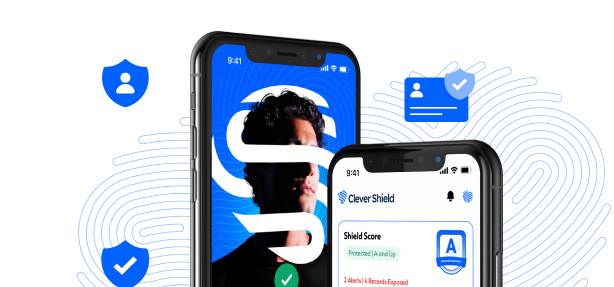Identity theft isn’t just a financial hit—it can hijack your name, your records, and your sense of control. Victims describe the recovery as a maze with locked doors: endless calls, contradictory instructions, and months of waiting while the damage spreads. This guide breaks down why clearing your name feels so hard, the hidden costs most people underestimate, and exactly how Clever Shield steps in to carry the load so you don’t have to fight alone.
The First Shock—and Why the Clock Starts Immediately
For many people, the nightmare starts with a jolt: a collection notice for a debt you don’t recognize, a card decline, a “return filed” message from the IRS, or a login alert you didn’t trigger. The instinct is to investigate slowly. Don’t. Fraud accelerates fast because data is copied and resold within hours. Your first moves should prioritize containment: freeze access to your credit, notify your financial institutions, and document everything.
A practical first step is to freeze credit with all three bureaus so new accounts can’t be opened in your name: start at the official pages for the Experian Credit Freeze, the Equifax Credit Freeze, and the TransUnion Credit Freeze. Set strong PINs and store them safely for when you need to temporarily lift the freeze.
If tax fraud is suspected, the IRS maintains detailed guidance at IRS Identity Theft Central. And the FTC’s hub at IdentityTheft.gov walks you through a personalized recovery plan and generates the affidavits many creditors will request.
Why Clearing Your Name Is So Difficult (and Slow)
Identity theft scatters false information across dozens of systems. That fragmentation creates five big obstacles:
- Burden of proof is on you. Creditors and bureaus often assume an account is valid until you prove otherwise. You’ll be asked for affidavits, copies of ID, police report numbers, and certified letters—each with their own format and deadline. The FTC’s consumer guidance on identity theft sets expectations clearly; it’s worth a read: FTC: What to Know About Identity Theft.
- Every institution has a different playbook. Banks, lenders, utilities, healthcare providers, the IRS, and credit bureaus all have different forms, timelines, and definitions of “sufficient proof.” You end up repeating the same story to ten different parties.
- Asynchronous timelines. One creditor might remove a fraudulent tradeline in a week while another takes 45 days. Meanwhile, collection activity and interest can continue, poisoning your credit.
- Data whack-a-mole. Even after removal, bad data can reappear when agencies sync with outdated sources. Without a tight paper trail, you can be forced to re-dispute.
- Emotional bandwidth drains. Every hour on hold is an hour you don’t spend working, resting, or taking care of family. The process can feel designed to wear you down.
The Hidden Costs People Don’t Budget For
Most victims fixate on dollar losses, but the bigger costs are often indirect:
- Credit score fallout. Fraudulent late payments and collections tank scores, which translates into higher interest rates, higher deposits for utilities, and insurance pricing penalties. Even after you win disputes, score recovery can lag.
- Opportunity cost. Missed mortgage rate locks, delayed rentals, or lost job opportunities due to background-check flags are common. Those missed moments have a real price tag.
- Time and wages. The average victim spends well over a hundred hours resolving identity theft. That’s weeks of time you don’t get back.
- Stress and health. Constant hypervigilance—checking statements, answering unknown calls, waiting for the next notice—feeds anxiety and sleep loss. For context and coping resources, consult the Identity Theft Resource Center or review the FTC’s guidance above.
If medical identity theft is involved, expect extra complexity: incorrect data can contaminate your health records until it’s fixed with providers and insurers. The FTC also publishes helpful articles on medical identity theft and what to ask providers when correcting records (start at the FTC link above).
Legal Complications You Didn’t Ask For
Not all identity theft is purely financial. Three legal vectors create outsized pain:
- Tax identity theft. A fraudster files a return before you do. The IRS will need to validate your identity; you may have to file specific forms and wait through investigation windows. Begin here: IRS Identity Theft Central.
- Criminal identity theft. Someone uses your name at arrest. Clearing this can require sworn statements, court records, and sometimes an attorney to correct databases.
- Medical identity theft. Care or prescriptions billed in your name can corrupt your medical history. That’s dangerous for future treatment and financially devastating if bills reach collections.
When these happen together—say, tax fraud and credit fraud at once—the complexity compounds quickly. Coordination, documentation, and persistence become everything.
Your Immediate Battle Plan (Step by Step)
Use this checklist to contain damage and build momentum. Keep a folder (digital or physical) with copies of everything.
- Place a credit freeze at each bureau: Experian, Equifax, and TransUnion. This blocks most new-account fraud.
- Create an FTC Identity Theft Report at IdentityTheft.gov. This generates official documents many creditors require, including an affidavit.
- Notify impacted banks and card issuers. Ask for account closures/replacements and dispute forms. Enable real-time alerts for any transaction activity.
- Pull and review your credit reports at AnnualCreditReport.com. Dispute unfamiliar tradelines and hard inquiries.
- Secure logins by changing passwords and enabling multi-factor authentication (email first, then financial accounts). For password and MFA best practices, see CISA’s guidance: CISA — Choosing and Protecting Passwords.
- File with the IRS, if needed. If your e-file is rejected or you suspect tax fraud, follow the steps at IRS Identity Theft Central.
- Consider a fraud alert (especially if you’re not ready to freeze). The CFPB explains fraud alerts and how creditors must verify identity before opening accounts.
- Document all calls and deadlines. Note date, time, who you spoke with, case numbers, and promised actions. Deadlines matter for dispute windows.
If a child’s identity may be involved, place a protective freeze for minors and follow the FTC’s guidance here: FTC — Child Identity Theft. For older relatives, share AARP’s practical tips and scam alerts: AARP Scams & Fraud.
Why Many People Give Up Midway (and What It Costs)
Victims often stall after the first few wins—one card refunded, one tradeline removed—because the process is draining. Unfortunately, unfinished cleanups can leave errors that resurface months later. Collections can be resold, and outdated files can sync back into your reports. The cost of giving up is living with a semi-permanent cloud over your name: higher interest on every loan, random denials, and the stress of not knowing what else is out there.
How Clever Shield Handles the Heavy Lifting
Clever Shield exists so you don’t have to become your own paralegal, investigator, and project manager. Here’s what hands-on restoration looks like in practice:
- Licensed restoration specialists assigned to your case. We contact creditors, collectors, and credit bureaus on your behalf; we submit affidavits, police report numbers (when applicable), and certified letters; and we track removals until they’re final.
- Government coordination. If the IRS, Social Security Administration, or state agencies are involved, we help prepare the right forms and keep the process moving.
- Paper trail protection. We maintain an audit-ready log of every dispute, response, and removal so bad data doesn’t creep back.
- Real-time monitoring + alerts. If new exposures pop up (for example, your email shows in a fresh breach), you get alerted fast so we can respond before damage spreads.
- $1 million identity theft insurance. Eligible out-of-pocket costs—lost wages, legal fees, document replacement, notarization—are covered so you aren’t paying to fix a crime you didn’t commit.
The outcome isn’t just “an alert.” It’s resolution: fraudulent accounts removed, reports corrected, and your name cleared.
After the Cleanup: How to Stay Clear
Restoration isn’t the finish line; it’s the reset. Lock in safer habits to keep the risk low:
- Keep the credit freeze on by default; temporarily lift it only when applying for credit.
- Rotate passwords on critical accounts and enable MFA everywhere it’s offered
- Use transaction and sign-in alerts from your bank and email providers so anomalies are obvious.
- Shred or lock away documents with SSNs, account numbers, or medical info.
- Teach the family. Children and seniors are prime targets. Freeze minors’ credit (see FTC — Child Identity Theft). Walk older relatives through common red flags (see AARP Scams & Fraud).
A few official resources worth bookmarking: the FTC’s identity theft hub at consumer.ftc.gov for step-by-step checklists; IdentityTheft.gov for generating reports and letters; the IRS portal for tax-specific issues at IRS Identity Theft Central; and AnnualCreditReport.com for monitoring your credit files.
FAQs
1) Is a credit freeze enough to stop identity theft?
A freeze is powerful against new account fraud, because lenders can’t pull your report. It doesn’t stop misuse of existing accounts, tax fraud, or medical identity theft. Pair it with monitoring and strong account security.
2) Will my credit fully recover after disputes?
Yes, but timing matters. The faster fraudulent items are removed, the faster your score rebounds. Some knock-on effects (like higher insurance rates) can lag until the next underwriting cycle.
3) Do I have to file a police report?
Not always. Many creditors accept an FTC identity theft affidavit from IdentityTheft.gov. Some still request a police report—especially for large accounts or criminal-identity cases.
4) What if the same fraud keeps coming back?
That’s usually a data-sync problem between furnishers and bureaus. A documented paper trail (and persistence) forces permanent corrections.
5) Can kids really be victims?
Yes. Criminals love “clean” SSNs with no credit history. Freezing a child’s credit and monitoring for school or medical misuse is smart (see the FTC guide).
6) How long does recovery take?
DIY can take months to a year or more. With expert restoration pushing in parallel across creditors and bureaus, timelines shrink significantly.
Conclusion: Don’t Let the Process Steal Your Life
Clearing your name after identity theft is more than a series of forms—it’s a fight against fragmentation, inertia, and exhaustion. You can do it yourself, but it will cost time, attention, and opportunities. With Clever Shield, you get licensed specialists, real-time monitoring, and insurance support that turns an overwhelming solo fight into a managed process with a clear finish line. The goal isn’t just to remove fraudulent accounts—it’s to restore your name, your credit, and your peace of mind.
If you’re seeing red flags—or you simply want to know what’s already out there—start with a quick scan and let us help you take it from there.





